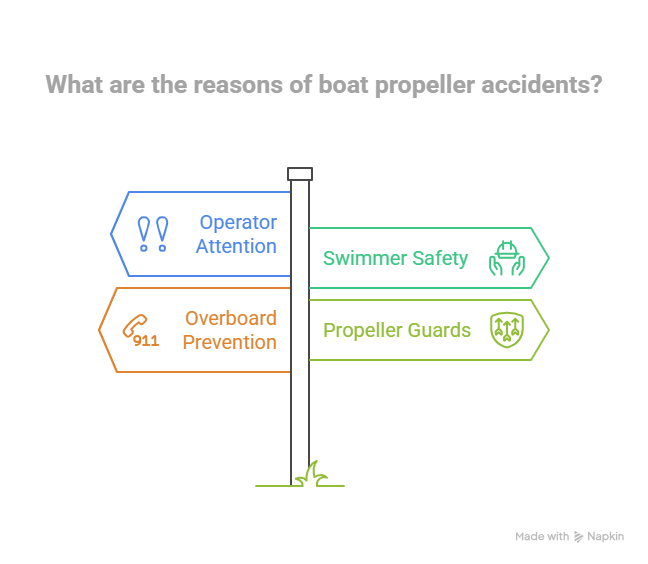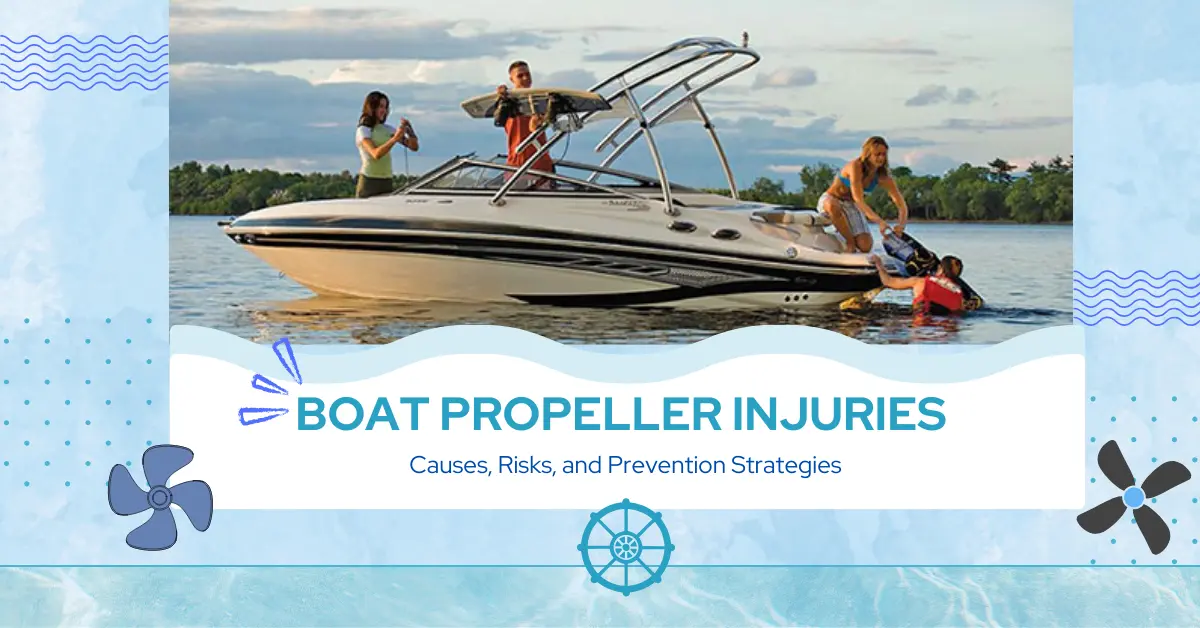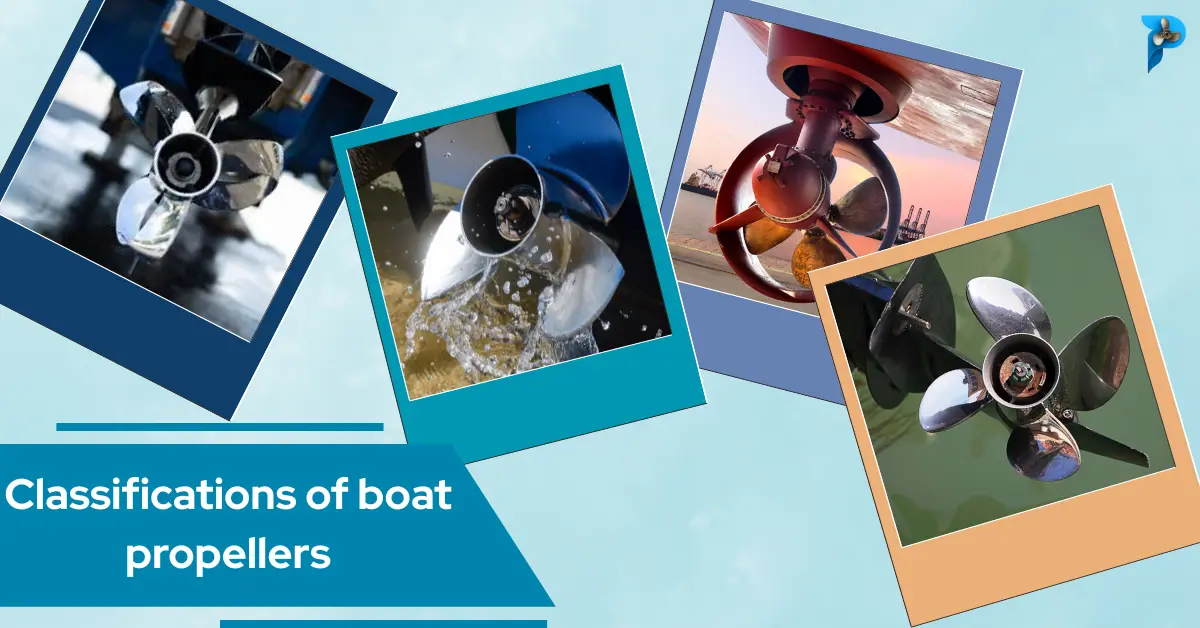Every year, boat propeller injuries cause devastating accidents that lead to severe lacerations, amputations, and even fatalities.
A standard 3-blade propeller operating at an average speed of 1,200 to 3,200 RPM can deliver up to 150 impacts per second.
It can cut through a human body from head to toe in under 0.1 seconds.
A moment of distraction, an inexperienced driver, or the absence of a propeller guard can turn a fun day on the water into a life-threatening emergency. Swimmers, divers, and water sports lovers are especially at risk.
Statistics from the U.S. Coast Guard’s 2022 Recreational Boating Statistics (the most recent report) reveal that more than 30 people die every year as a result of a propeller strike.
In this guide, we’ll uncover what causes boat propeller injuries, who is most at risk, and the best boat propeller safety practices to prevent these dangerous accidents.
Therefore, let’s dive in and ensure that your next boating trip is fun and safe.
Understanding Boat Propeller Injuries
Boat propellers cause hundreds of serious injuries each year.
These accidents often result from direct contact with rotating blades, leading to deep lacerations, broken bones, or even fatalities.
What Are Boat Propeller Injuries?
Boat propeller injuries are severe strikes caused by contact with the spinning blades of a boat’s propeller.
These injuries can range from deep cuts and lacerations to devastating amputations, and in some tragic cases, they can lead to death.
Boat propellers operate below the water line, so they’re invisible to boat operators, swimmers, skiers, and others.
Common injuries include propeller-induced lacerations to the legs, arms, or torso, and in the worst-case scenario, loss of limbs.
Implementing effective boating safety measures can significantly reduce the chances of these injuries occurring.
Who Is at Risk?
Boat propeller injuries pose a significant risk to anyone near or in the water when a boat is running.
The primary groups at risk include swimmers, divers, and water sports enthusiasts such as water skiers or wakeboarders.
Additionally, passengers on a moving boat can accidentally come into contact with the propeller if they fall or lose balance.
Ensuring swimmer safety near boats is essential to avoid accidents. Boating safety includes proper awareness of where individuals are in the water.
For example, maintaining a safe distance from boats or ensuring that passengers understand the risks of propeller exposure.
How Common Are Boat Propeller Injuries?
Recent U.S. Coast Guard recreational boating safety reports (2001-2006) indicate that 28 to 47 people are killed annually by “struck by boat motor or propeller” accidents in the United States.
The same reports also document approximately 185 to 265 accidents each year involving boat motor or propeller strikes.
These injuries can happen in the blink of an eye, with the potential for devastating consequences.
While most of these accidents are preventable with proper boating safety measures, many boaters still overlook the dangers of operating near people in the water.
Causes of Boat Propeller Accidents

When a boat’s propeller is in motion, it generates a downward and inward flow of water toward the boat’s center.
People swimming near the stern can be caught in this powerful hydrodynamic current. That can pull them toward the spinning blades.
In other cases, accidents occur when a boat strikes a person in the water, often due to operator carelessness or lack of attention. Propeller strike accidents occur when:
1. Operator Inattention or Inexperience
One of the leading causes of boat propeller accidents is operator inattention or lack of experience.
Boat operators who are distracted, whether from distractions on board or not paying attention to the surroundings, are more likely to overlook swimmers, divers, or other boats in the vicinity.
2. Swimmers Too Close to Running Boats
Swimmer safety near boats is a critical concern when discussing boat propeller accidents.
Swimmers or divers who are too close to a running boat are at significant risk of coming into contact with the spinning propeller blades.
In many cases, boaters may not realize that swimmers are near the boat or may underestimate the danger zone around the vessel.
Research shows that propeller injuries are most likely to occur when swimmers or divers are within 20 feet of a moving boat.
3. Circle of Death: Operator Falls Overboard
If a boat operator falls overboard and the boat is left without steering, it can start to circle uncontrollably.
This creates a dangerous situation where the boat may run over the operator, or anyone else, who’s still in the water.
This phenomenon is known as the “Circle of Death”.
It occurs because the boat’s propulsion keeps it moving in a tight loop and makes it difficult for anyone in the water to escape the path of the spinning vessel.
4. Lack of Propeller Guards
Another significant contributor to boat propeller accidents is the lack of propeller guards. A propeller guard is a safety device designed to cover the spinning blades of the propeller.
It prevents accidental contact with swimmers, divers, and others in the water.
Without this vital piece of equipment, the chances of severe injuries rise significantly.
Propeller guards can reduce the severity of accidents by providing a barrier between the propeller and individuals in the water.
The Consequences of Propeller Accidents
According to legal and safety experts, it’s estimated that between 25 and 35 deaths occur annually as a result of being struck by propellers.
Apart from the physical damage, there’s some more. Those are:
1. Physical Injuries: Lacerations, Amputations, and Drowning Risks
A study featured in the Journal of Forensic Sciences revealed that, contrary to popular belief, propeller injuries are not typically characterized by “chopping” or “hacking” wounds.
Instead, most injuries caused by boat propellers lead to fractures and broken bones, with fatalities often resulting from blunt force trauma rather than cuts or lacerations.
In incidents where boat propellers strike the head or torso, the injuries are particularly severe. The impact can cause significant damage to vital organs beneath the surface.
Propeller accidents are also linked to drowning risks, as the trauma caused by the propeller can lead to unconsciousness or panic. It makes it harder for the victim to stay afloat.
2. Emotional and Financial Impact on Victims and Families
Beyond the physical damage, boat propeller accidents also carry a heavy emotional and financial toll on the victims and their families.
Survivors of propeller accidents often face long-term physical rehabilitation and psychological trauma due to the nature of the injuries.
The emotional impact can be overwhelming, with victims struggling with post-traumatic stress, anxiety, and depression.
In addition, financial burdens can quickly pile up as medical expenses for surgery, rehabilitation, and long-term care can reach astronomical figures.
3. Legal Liabilities for Boat Owners and Operators
When a boat propeller accident occurs, legal liabilities may follow.
Boat owners and operators could face significant legal repercussions if they are found negligent in ensuring safety measures are in place.
This includes not maintaining a proper lookout, operating a boat under the influence of alcohol, or failing to install essential safety equipment like propeller guards.
According to the National Association of Boating Law Administrators (NASBLA), boat operators who fail to comply with safety regulations can be held accountable for the injuries sustained by others.
How to Prevent Boat Propeller Injuries?
Here’s a detailed breakdown of how to prevent boat propeller injuries:
1. Use a Propeller Guard
One of the most effective ways to prevent boat propeller injuries is the installation of a propeller guard, such as the Outboard Propeller Safety Guard.
This is an essential safety feature that acts as a protective barrier between the spinning blades and swimmers, divers, and passengers.
Propeller guards are especially important for boats operating in crowded areas where people are often in the water.
They significantly reduce the risk of serious injuries by minimizing direct contact with the blades.
2. Maintain a Safe Distance from Swimmers
When operating a boat, always ensure that you maintain a safe distance from swimmers and others in the water.
The U.S. Coast Guard recommends keeping at least 100 feet between the boat and anyone in the water, especially when operating at high speeds.
Practicing this simple rule can significantly reduce the risk of propeller-related injuries.
3. Install an Engine Cut-Off Switch
An engine cut-off switch is another vital safety feature that can prevent boat propeller accidents.
This device automatically stops the engine if the operator is thrown overboard, preventing the boat from running unchecked and circling in dangerous patterns.
This is especially important to avoid the “Circle of Death”.
It’s a dangerous phenomenon where a runaway boat can injure or even kill someone in the water.
Installing an engine cut-off switch, such as the Baomain Red Sign Emergency Stop Switch, ensures that if an emergency occurs, the boat will stop immediately.
Make sure to check the safety equipment on your boat, and don’t forget to wear the engine cut-off switch lanyard while operating the vessel.
4. Always Keep a Lookout
One of the simplest yet most effective measures to avoid propeller injuries is to always keep a lookout while operating your boat.
Having someone on shore as a designated lookout can help spot swimmers, divers, or obstacles in the water.
Many boating accidents occur when the operator is distracted or unaware of people in the water.
Constant vigilance and good boating safety practices ensure that swimmers and boaters alike remain safe.
5. Use Proper Boating Signage
Clear warning signs can notify swimmers, divers, and other boaters of the danger zone around your boat.
Install signs that indicate where swimmers should stay and provide reminders of the need to stay clear of the propeller.
Proper signage can help avoid confusion and prevent propeller injuries by providing clear, visual reminders to stay at a safe distance.
6. Avoid Alcohol While Boating
Just like driving a car, boating under the influence is a leading cause of boating accidents and propeller injuries.
Alcohol impairs judgment, coordination, and reaction time, which makes it difficult to miss safety signals in an emergency.
According to the National Association of State Boating Law Administrators (NASBLA), alcohol use continues to be the leading known contributing factor in recreational boating deaths in the United States.
Specifically, alcohol was listed as the leading factor in 18% of deaths.
Additionally, according to the U.S. Coast Guard’s 1999 Boating Statistics report, alcohol involvement accounted for 26% of all boating fatalities that year.
To prevent accidents, it is essential to avoid alcohol while boating.
What to Do If a Boat Propeller Injury Occurs
If a boat propeller injury occurs, follow these emergency steps to ensure the best possible outcome:
1. Turn Off the Engine Immediately
If a person is struck by a boat propeller, the first step is to shut down the engine to prevent further injury and stop the boat from moving.
2. Call Emergency Services (911 or Marine Rescue)
In any accident, every second counts. Call emergency responders immediately to ensure the victim receives urgent medical attention.
3. Stop the Bleeding
Boat propellers cause deep lacerations, amputations, and severe trauma. Use a clean cloth or bandage to apply direct pressure to the wound and slow excessive bleeding.
If possible, elevate the injured area above the heart.
4. Move the Victim Safely
If the victim is still in the water, carefully lift them onto the boat without causing additional harm. Avoid unnecessary movement, especially if there are head, spinal, or severe limb injuries.
5. Provide CPR if Necessary
In serious boating accidents, victims may lose consciousness or stop breathing due to shock or blood loss. If needed, begin CPR (cardiopulmonary resuscitation) while waiting for emergency responders.
6. Prevent Further Injury
Keep the injured person warm, calm, and stable. Boating accidents can cause hypothermia, especially if the person has been in cold water for an extended period.
7. When to Seek Medical Attention
Signs that require immediate medical help:
- Excessive bleeding that doesn’t stop with pressure.
- Deep cuts or exposed bones/muscles
- Signs of shock (pale skin, confusion, weak pulse)
- Numbness or loss of sensation in the injured area
- Difficulty breathing or chest injuries
General Boating Safety Concerns
The U.S. Coast Guard emphasizes the importance of following key safety guidelines to reduce risks while on the water.
- Ensure Passengers Are Seated Securely – Every individual onboard should remain seated inside the boat at all times. Sitting on the bow, transom, or gunwale increases the risk of falling overboard.
- Cross-Wakes with Caution – When encountering waves or wakes, slow down and cross at an angled approach instead of head-on to maintain stability.
- Limit Alcohol Consumption – Boating under the influence is a leading cause of boating accidents. Operators and passengers should avoid excessive drinking to ensure safe navigation.
- Respect Diver-Down Flags – Maintain a safe distance of at least 100 feet from diver-down flags in rivers, inlets, and navigation channels. On larger water, maintain a 300-foot distance.
- Retrieve Fallen Skiers Quickly – If a water skier falls, the boat operator should immediately return to them. Many skiers have sustained serious injuries or lost their lives while waiting to be picked up.
- Wear High-Visibility Life Jackets – Brightly colored life vests improve visibility and help prevent accidents by making individuals more noticeable to other boats.
- Avoid Using Reverse Gear Near Skiers – Never put the boat engine in reverse while backing toward a skier, as this could result in severe injuries from the boat’s propeller.
- Verify Everyone Is Seated Before Engaging the Engine – Before shifting into gear, the operator should confirm that all passengers are securely seated to prevent falls overboard.
- Stay Out of Designated Swimming Areas – Never operate a boat in marked swimming zones, as these areas are meant for swimmers, divers, and non-motorized water activities.
- Avoid Reckless Behavior with Watercraft Activities – Purposely throwing individuals off jet skis, tubes, or other towable watercraft can result in serious injuries.
Legal Consequences of Boating Negligence
In Colombo v. BRP US, Inc., two teenage girls suffered life-altering injuries after falling from the back of a personal watercraft (PWC) and being propelled into the path of a jet thrust.
- One victim sustained severe injuries to her rectum and vagina, resulting in chronic pain and long-term complications with bowel control.
- The other suffered similar trauma and was informed by medical professionals that she would never be able to give birth naturally.
Despite previous reports of similar injuries, the manufacturer failed to provide adequate warnings about the risks.
Evidence presented in court revealed that the manufacturer had prior knowledge of these dangers but did not sufficiently warn consumers about the necessity of wearing protective wetsuits.
As a result, the court upheld a $7.4 million compensation for the victims, holding the manufacturer accountable.
Therefore, by following these boating safety guidelines, operators and passengers can significantly reduce the risk of boat propeller accidents, personal watercraft injuries, and other boating-related dangers.
Read Also: Boat Propeller Maintenance
Final Thoughts
Boating should be fun and safe, yet boat propeller accidents remain a serious risk. However, most are preventable.
Simple steps like using propeller guards, installing an engine cut-off switch, keeping a safe distance from swimmers, and avoiding alcohol while boating can significantly reduce dangers.
Investing in boating safety equipment and staying alert can save lives. Take action now and prioritize safety, and ensure a safer experience for everyone on the water.
Best of luck!






